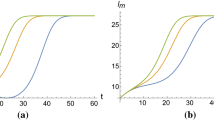Abstract
In this paper, we deal with the logistic growth model with a time-dependent carrying capacity that was proposed in the literature for the study of the total bacterial biomass during occlusion of healthy human skin. Accounting for data and model errors, randomness is incorporated into the equation by assuming that the input parameters are random variables. The uncertainty is quantified by approximations of the solution stochastic process via truncated series solution together with the random variable transformation method. Numerical examples illustrate the theoretical results.








Similar content being viewed by others
References
Casabán MC, Cortés JC, Navarro-Quiles A, Romero JV, Roselló MD, Villanueva MD (2016) A comprehensive probabilistic solution of random SIS-type epidemiological models using the random variable transformation technique. Commun Nonlinear Sci Numer Simul 32:199–210
Casella G, Berger RL (2002) Statistical inference, 2nd edn. Duxbury, Pacific Grove
Dorini FA, Sampaio R (2012) Some results on the random wear coefficient of the Archard model. J Appl Mech 79(5):051008
Neckel T, Rupp F (2013) Random differential equations in scientific computing. Walter de Gruyter, Berlin
Rudin W (1976) Principles of mathematical analysis. In: International series in pure & applied mathematics, 3rd edn. McGraw-Hill Education, ISBN: 9780070542358
Safuan HM, Jovanoski Z, Towers IN, Sidhu HS (2013) Exact solution of a non-autonomous logistic population model. Ecol Model 251:99–102
Safuan H, Towers IN, Jovanoski Z, Sidhu HS (2011) A simple model for the total microbial biomass under occlusion of healthy human skin. In: MODSIM2011, 19th international congress on modelling and simulation. Modelling and simulation Society of Australia and New Zealand, pp 733–739
Scheffé H (1947) A useful convergence theorem for probability distributions. Ann. Math. Stat. 18(3):434–438
Tenorio L (2017) An introduction to data analysis and uncertainty quantification for inverse problems, vol 3. SIAM, Philadelphia
Udwadia FE (1989) Some results on maximum entropy distributions for parameters known to lie in finite intervals. SIAM Rev 31(1):103–109
van der Vaart AW (1998) Asymptotic statistics. Cambridge University Press, Cambridge. ISBN: 9780521784504
Wolfram Research Inc (2019) Mathematica, version 12.0, Champaign (2019)
Author information
Authors and Affiliations
Corresponding author
Ethics declarations
Conflicts of interest
The authors declare that they have no conflict of interest.
Additional information
Communicated by Valeria Neves Domingos Cavalcanti.
Publisher's Note
Springer Nature remains neutral with regard to jurisdictional claims in published maps and institutional affiliations.
This work has been supported by the Spanish Ministerio de Economía, Industria y Competitividad (MINECO), the Agencia Estatal de Investigación (AEI), and Fondo Europeo de Desarrollo Regional (FEDER UE) Grant MTM2017-89664-P.
Rights and permissions
About this article
Cite this article
Calatayud, J., Cortés, JC., Dorini, F.A. et al. On a stochastic logistic population model with time-varying carrying capacity. Comp. Appl. Math. 39, 288 (2020). https://doi.org/10.1007/s40314-020-01343-z
Received:
Revised:
Accepted:
Published:
DOI: https://doi.org/10.1007/s40314-020-01343-z




